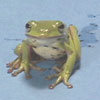Join us for conversations that inspire, recognize, and encourage innovation and best practices in the education profession.
Available on Apple Podcasts, Spotify, Google Podcasts, and more.

Animal (frog)
There are life processes that are so much a part of our experience that it’s easy to take them for granted. Reproduction is one of these processes. It seems quite simple: life cycles result in offspring that resemble their parents. The life-cycle patterns of different life forms vary, but the outcome is always the same–the continuity of life is ensured from generation to generation. The next two sessions explore two different life-cycle patterns: animals and plants. In Session 3 we’ll focus on the Animal kingdom as one example of life cycles that involve sexual reproduction. We’ll also explore the underlying role of DNA in the process of reproduction.
“What was it before?” Dr. Rodger Bybee, representing Science T.R.A.C.S. of the Biological Sciences Curriculum Study (BSCS), brings us into the world of elementary school children as they answer this question during their investigation of life cycles. Research on children’s ideas is played out in the Science Studio where second and third graders discuss “What comes before an egg?” An exploration of the role of DNA in reproduction follows, starting with body cell reproduction. This is contrasted with sex cell production, which results in the reliable transfer of hereditary information from parents to offspring in sexual reproduction.
An interview with Dr. Sigal Klipstein answers the question “What comes AFTER an egg?” as she describes the process of embryo development in animals. She also contrasts the technology of cloning with sexual reproduction and describes some pros and cons of this process. Mary Bitterlich’s third graders in Lakewood, Colorado, offer us a firsthand view of the study of animal life cycles. We visit them as they finish a Science T.R.A.C.S. unit where the darkling beetle–an insect–is their animal example.
An overview of different life-cycle patterns within the Animal kingdom follows, including fish, amphibians, birds, reptiles, and mammals. Finally, Bottle Biology returns, with Dr. Paul Williams introducing us to the “Brassica & Butterfly System,” one strand of this Web-based activity that brings together the life cycles of a plant and an animal.